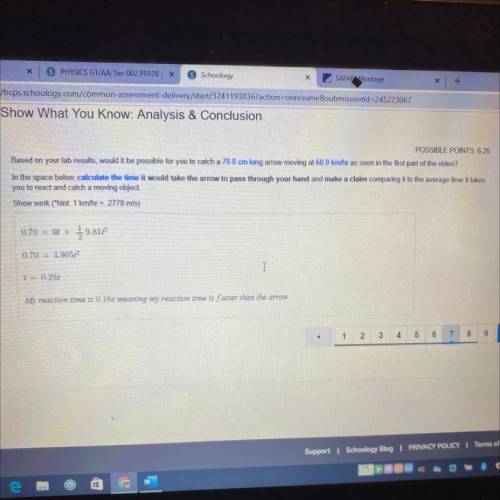Show What You Know: Analysis & Conclusion
7 of 9
POSSIBLE POINTS. 6.25
Based on you...

Physics, 06.11.2020 02:00 agilitygirl1
Show What You Know: Analysis & Conclusion
7 of 9
POSSIBLE POINTS. 6.25
Based on your lab results would it be possible for you to catch a 70.0 cm long arrow moving at 60.0 kmhr as seen in the first part of the video?
In the space below, calculate the time it would take the arrow to pass through your hand and make a claim comparing it to the average time it takes
you to react and catch a moving object
Show work ("hint 1 kmhr = 2778 m/s)


Answers: 2
Another question on Physics

Physics, 21.06.2019 14:00
Now that the first three steps have been explained, identify the next three steps, in order. calculate the magnitude of r sum vector components calculate a and b magnitudes calculate the direction of r, calculate x,y components step 4 step 5 step 6
Answers: 1

Physics, 21.06.2019 22:30
Solar cell a produces 100 joules of energy, when a light source is shown on it for 3 minutes. solar cell b produces 200 joules of energy when the same light source is shown on it for 5 minutes. which solar cell works better? a) solar cell b, because it produces more energy. b) solar cell b, because it generates more power. c) solar cell a, because it produces energy quicker. d) solar cell a, because it generates a greater wattage. eliminate
Answers: 2

Physics, 22.06.2019 15:30
Ametal ring 4.20 cm in diameter is placed between the north and south poles of large magnets with the plane of its area perpendicular to the magnetic field. these magnets produce an initial uniform field of 1.12 t between them but are gradually pulled apart, causing this field to remain uniform but decrease steadily at 0.240 t/s . (a) what is the magnitude of the electric field induced in the ring? (b) in which direction (clockwise or counterclockwise) does the current flow as viewed by someone on the south pole of the magnet?
Answers: 2

Physics, 22.06.2019 22:30
The drag force, fd, imposed by the surrounding air on a vehicle moving with velocity v is given by fd = cdaρv 2/2 where cd is a constant called the drag coefficient, a is the projected frontal area of the vehicle, and ρ is the air density. an automobile is moving at v = 80 kilometers per hour with cd = 0.28, a = 2.3 m2, and ρ = 1.2 kg/m3.
Answers: 2
You know the right answer?
Questions

English, 11.09.2020 17:01

Mathematics, 11.09.2020 17:01

English, 11.09.2020 17:01

Mathematics, 11.09.2020 17:01

Mathematics, 11.09.2020 17:01

Mathematics, 11.09.2020 17:01

Physics, 11.09.2020 17:01

Mathematics, 11.09.2020 17:01

History, 11.09.2020 17:01

Mathematics, 11.09.2020 17:01

Mathematics, 11.09.2020 17:01

Mathematics, 11.09.2020 17:01

Physics, 11.09.2020 17:01

Mathematics, 11.09.2020 17:01

Mathematics, 11.09.2020 17:01

Mathematics, 11.09.2020 17:01

Mathematics, 11.09.2020 17:01

Mathematics, 11.09.2020 17:01

Mathematics, 11.09.2020 17:01

Mathematics, 11.09.2020 17:01



